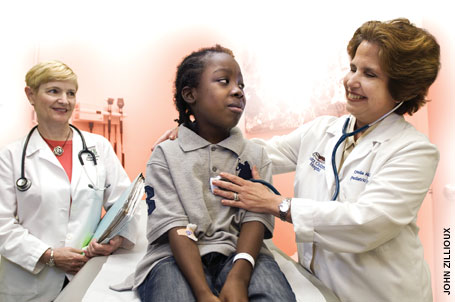Mimose Francois’s heart aches when she sees her 8-year-old son, Nikenson, in the searing pain sickle cell anemia patients sometimes endure. When she thinks of his future, she worries about the severe and life-threatening problems people with the disease often deal with for the rest of their lives.
“This disease has disrupted so many lives,” Francois said on a recent morning, as she walked by several parents and young children to take her usual seat in a colorful waiting room at University of Miami/Jackson Memorial Medical Center. In a few minutes Nikenson would be seen by pediatric sickle cell nurse coordinator Tally Hustace, ARNP, and examined by Ofelia Alvarez, M.D., pediatric clinical director at the UM Sickle Cell Center.
 |
| Pediatric sickle cell nurse coordinator Tally
Hustace, ARNP, left, and Ofelia Alvarez, M.D., pediatric clinical director at the UM Sickle Cell Center, examine patient Nikenson Alexandre. |
“I wish for a cure, but I’m willing to help with anything that could bring some relief,” she said.
Indeed, mother and son already have helped the cause considerably. When Nikenson was 18 months old, he was among the patients enrolled in one of the largest sickle cell anemia studies of its kind—and the promising results could change the standard of care for very young children with the disease.
From October 2003 through September 2009, researchers from the Miller School and 13 other centers around the United States conducted a randomized double-blinded trial that determined the drug hydroxyurea appears effective in preventing organ dysfunction and clinical complications in infants and toddlers. The results of the two-year NIH-funded clinical trial were published in the May 14, 2011, issue of the British medical journal The Lancet.
“This study represents a major step forward in treatment of the often devastating symptoms of sickle cell anemia in the infant or toddler—principally pain, painful swelling of the hands and feet,” said Daniel Armstrong, Ph.D., professor and associate chair of pediatrics and director of the UM Sickle Cell Center.
Elaborating, Armstrong noted the study also indicates a strong, but not statistically significant, reduction of hospitalization, acute chest syndrome, and need for transfusion. Regardless, “before hydroxyurea, the only treatment options were blood transfusions every three to four weeks, bone marrow transplantation, or acute management of symptoms, often involving repeated hospitalization.”
Fifteen years ago a study of hydroxyurea in adults demonstrated that the medication reduced episodes of pain and acute chest syndrome, hospitalizations, and transfusions in adults with sickle cell disease. Subsequent multiple smaller studies showed similar benefits and minimal toxicity in school-age children and adolescents.
In 1999 the U.S. National Heart, Lung and Blood Institute began the research with a pilot trial (HUSOFT), which showed that very young children tolerated a liquid hydroxyurea formulation; they then moved on to the Phase III BABY HUG trial.
Armstrong and Julio Barredo, M.D., director of the Division of Pediatric Hematology/Oncology at UM who was then at the Medical University of South Carolina and a co-author on the Lancet publication, were part of the original study design and steering committee for the BABY HUG study. |


